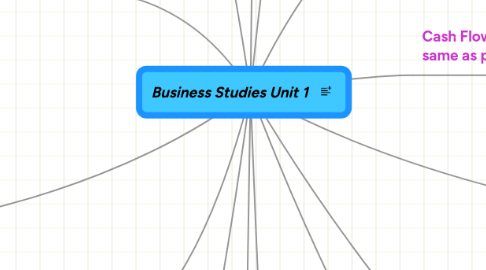
1. Legal Structure of a Business
1.1. Sole Trader- Unlimited Liability
1.1.1. +Freedom (own boss)
1.1.2. +Keep all profit
1.1.3. +Less Paperwork
1.1.4. +No legal costs
1.1.5. -Risk
1.1.6. -Work long hours
1.1.7. Limited Skills
1.1.8. No cover if ill
1.1.9. Unlimited Liablitiy
1.2. Partnerships e.g Doctors and Solicitors
1.2.1. More start up capital
1.2.2. More ideas
1.2.3. More skills
1.2.4. Can cover when ill
1.2.5. Unlimited Liablility
1.2.6. risk of conflict
1.2.7. liable for decisions made by partners
1.3. Private Ltd ( LTD )
1.3.1. Often Small family businesses
1.3.2. Dont have share prices on stock exchange
1.4. Public Ltd (PLC)
1.4.1. Sell shares to public
1.4.2. shares freely transferable
1.4.3. Need over 50k in share capital to start
2. Franchises
2.1. Franchisor
2.1.1. Saves wage cost
2.1.2. Get a share of profits
2.1.3. Fast growth
2.1.4. Reduced risk
2.1.5. Share Rewards
2.1.6. Can damage reputation
2.2. Franchisee
2.2.1. Reputation Name/Idea
2.2.2. Marketing/Advertising done nationally
2.2.3. Training provided
2.2.4. Leese machinery/equipment
2.2.5. Banks more willing to lend
2.2.6. Pay to use name
2.2.7. Share Profits
2.2.8. Bad reputation spreads
2.2.9. Follow rules of franchisor
3. Location
3.1. Cost Benefti Analysis - Weighing up the costs of a business against potential benefits.
3.1.1. Break even to measure this
3.1.1.1. Contribution per unit = Selling price per unit - variable costs per unit
3.1.1.1.1. Break even = Fixed costs divided by contribution per unit
3.2. Manufactoring businesses providing bulky finished products need to be located near to customers.
3.3. Manufactoring businesses starting with heavy raw materials producing lightweight end products need to be located near raw materials.
3.4. Good location needs a good infrastrucute (motorways, rail links, ports and airports)
3.4.1. required for import of raw materials, transport of finish products and getting staff to work
3.5. Must be located near support services (banking, IT assistance, engineering assistance)
3.6. Must be near College/Universities, Affordable housing, schools, medical, leisure, room for expansion.
3.7. Government provide grants, loans , equity investment and financial guidance as incentives for some areas.
3.8. Located near owners house
3.9. Some areas have better image e.g London/Paris for fashion.
3.10. Competition
3.11. However internet made locations more flexible.
4. Staff
4.1. Important to have a balance of full/part time.
4.2. New starting businesses should have part time staff until demand is stable
4.3. Permanent Staff have an ongoing contractn and garunteed salary. Severence pay
4.4. Tempory- Fixed period of time (e.g 6months) Contracts can be renewed
4.5. Business recruitment agencies used to advertise and find suitable candidates. Charge fee for service
4.6. Contractors used when businesses require specific specialist skill (short term basis) e.g cleaning, accountancy and building.
4.7. Some businesses find it difficult to attract the right candidates as they cannot offer the salaries larger companies offer.
4.8. Can be sued if candidates declined for race,sex or disabilities
5. Break even Analysis
5.1. Easy
5.2. Quick
5.3. forcast variations
5.4. persuade banks
5.5. if data is wrong results will be wrong
5.6. Assumes all products will be sold
5.7. Assumes variable costs rise steadily
6. budgets
6.1. Income
6.2. Expenditure
6.3. Profit
6.4. Help control income/expenditure
6.5. Help deligate authority
6.6. Help control/ motivate staff
6.7. If budget is wrong actual results will follow
6.8. Lead to false confidence
6.9. Doesnt account for machinery break down etc
7. Types of Market Segmentation
7.1. Age
7.2. Gender
7.3. Social Class
7.4. Lifestyle
7.5. Geographic
7.6. Frequency of purchase
8. Sample- Represent the market. Equal proportions. The bigger the better!
8.1. Random Sample- each member of the target population has an equal chance of being chosen.
8.2. Quota sample- a fixed number of serveral different segments each sharing a common feature(e.g age,gender)
8.3. Simple - Random (names from a hat)
8.4. Stratified - Split into groups , random selection from the groups
9. The supply chain
9.1. Starts with Raw Materials
9.1.1. Moves to manufactoring
9.1.1.1. Distribution to shops
9.1.1.1.1. Retailers sell to customers
9.2. Value is added at each stage e.g a Bead making factory turns plastic into beads, then the handbag manufacorer uses the beads for decoration
10. Protecting business models
10.1. Patent - Protects the product
10.2. Trademark - Protects the Logo or slogan
10.3. Copyrights- Copy written work and music.
11. Market Research
11.1. Why?
11.1.1. Spot Oportunities
11.1.2. Set targets
11.1.3. Check progress
11.2. Qualitive - Closed - Statistics
11.3. Quantative - Open- Personal Opinions
11.4. Primary Research (interview, questionaire, focus groups.)
11.4.1. Specific
11.4.2. Exclusive
11.4.3. Up to date
11.4.4. Expensive
11.4.5. Hard work
11.4.6. Slow
11.5. Secondary Research (second hand)
11.5.1. Fast
11.5.2. Cheap
11.5.3. Not exclusive
11.5.4. Out of date
11.5.5. errors
11.6. Not enough research can increase the risk of failing. A business must know what the market want
12. Part time stff
12.1. Cheaper
12.2. More flexible to demand
12.3. Better work/life balance
12.4. Wider range of skills
12.5. Hard to find
12.6. Less loyal
12.7. Less dedicated
12.8. Less exp
13. Business Plans
13.1. To get financial backing
13.2. Banks/Financers ask for one before investing.
13.3. Helps entrepeneur asses businesses strengths and weaknesses
13.4. Comparable to real performance
13.5. Areas of a Business Plan
13.5.1. Executive Summary - General overview (key points)
13.5.2. Business Summary - Type of business/products/serive provided. Future/ Legal.
13.5.3. Production Plan - How many products produced.
13.5.4. Marketing Plan - Defines the market, market research , promotions (USP)
13.5.5. Human Resources - Qualifications and exp of entrepeneur.
13.5.6. Operations plan - Location, own property/ machinery?
13.5.7. Financial Plan - Financial forecasts, break even/cash flow forcast.
13.6. Advice on creating a business plan
13.6.1. Business link, banks, websites, sample business plans, consultants and accountants.
14. Cash Flow (Not the same as profit)
14.1. Selling something on credit counts as profit now but it wont count as cash flow until it enters the account
14.2. Improve cash flow by:
14.2.1. Hold less stock
14.2.2. Give customers shorter credit periods
14.2.3. Get suppliers to give you longer credit periods
14.2.4. Sell equipment and lease/rent it.
